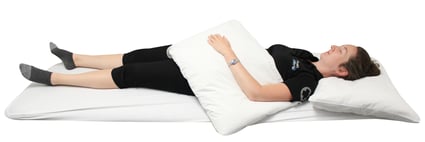
Do you experience back or neck pain? Do you wake up feeling sore? Have you considered checking your sleeping position? Here are some tips and exercises from a physiotherapist that could help relieve your pain and, hopefully, help you sleep like a dream!
How to Choose Your Sleeping Position?
If You Have Back Pain
Sleeping on Your Side: The Ideal Position
For those experiencing back pain, the best sleeping position is often on the side. Placing a pillow between your legs can help prevent spinal twisting, which may worsen discomfort. The key is to avoid pressure on your back and find a position that feels comfortable.

If You Prefer Sleeping on Your Back
Sleeping on your back is also an option if it feels comfortable for you. However, this position can sometimes increase back discomfort since it naturally arches the spine. To reduce pressure, try placing a thin pillow under your knees. This small adjustment may help relieve your pain.

Sleeping on Your Stomach: Best to Avoid, But a Compromise Exists
It’s best to avoid sleeping on your stomach, as this position keeps the spine extended and slightly rotated. Spending an entire night in this posture can be demanding and irritating for an already sore back.
If sleeping on your stomach is the only way you can rest, try this compromise: Use multiple pillows or a body pillow under your stomach and pelvis to position yourself in a “three-quarter” posture—somewhere between sleeping on your stomach and sleeping on your side.


If You Have Neck Pain
Avoid: Sleeping with Your Arms in the Air
If you suffer from neck pain, avoid sleeping with your arms raised, regardless of your sleeping position. This habit can create excessive tension in both the neural (nerve) and muscular systems, which may worsen neck pain. It can also cause tingling or numbness in your hands upon waking.


Supporting Your Arm: The Ideal Position
To ease neck or shoulder pain, try placing a pillow under your arm. If you sleep on your side, put the pillow under your top arm. If you have a painful shoulder, it’s usually more comfortable to sleep on the opposite side while supporting the sore shoulder with a pillow. If you sleep on your back, place a pillow under your arm so that it supports your hand resting on your stomach.


Neck Alignment Matters
Proper neck alignment is crucial in any sleeping position. To prevent muscle tension, your neck should be well-supported and not tilted too far up or down, whether you sleep on your side or your back.

Again, it’s best to avoid sleeping on your stomach, as this position keeps the neck in rotation and extension. If this is the only way you can fall asleep, try the same compromise recommended for lower back pain: Use multiple pillows or a body pillow under your stomach and pelvis to shift into a “three-quarter” position between sleeping on your stomach and your side. This reduces excessive neck rotation.
|
KEY TAKEAWAY: The most important factor in choosing your sleeping position is comfort. Some people can sleep in any position, while others can only rest in a specific way. Choose the position that feels most comfortable to help you fall asleep, then adjust it as needed to relieve pain. |
Extra Tip: Choosing the Right Pillow and Mattress for Quality Sleep
Choosing the Right Pillow
Once again, comfort should be the number one factor when selecting a pillow. Your pillow should support your head and conform to the shape of your neck to ensure proper alignment. Generally, you’ll need a thinner pillow if you sleep on your back and a thicker one if you sleep on your side. If you switch between these positions throughout the night, opt for a more flexible pillow that allows you to adjust its thickness.
Choosing the Right Mattress
Comfort is also the top priority when selecting a mattress. If you suffer from back or neck pain, it’s best to choose a mattress that is neither too firm nor too soft to prevent muscle spasms during the night.
A useful tip for couples: You shouldn’t feel movement when your partner turns over in bed. You also shouldn’t feel your body leaning toward their side when you’re both lying down. If this happens, it may be a sign that your mattress is too soft.
Related Article: Releasing Muscle Tension – Exercises for a Restful Sleep
These simple tips should help improve your nighttime comfort. Give them a try! And if your sleep-related pain persists, don’t hesitate to book a physiotherapy appointment for professional guidance.
Article written by Catherine Mireault-Germain, Physiotherapist.
Need to talk to a professional?
Other articles that might interest you...

Headache? It might not be from your night on the town!
Better understanding the possible causes Whether it’s after a bad night’s sleep, a late night out...

Releasing Muscle Tension: Exercises for Restorative Sleep
Do you often wake up with back or neck pain? Are morning aches ruining your day? To relieve these...

Tips for reducing morning soreness
How to improve your sleeping position When you feel pain, it’s normal to want to look for the...
 Home
Home